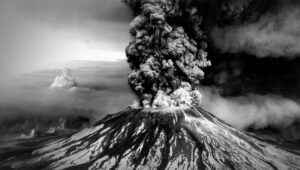When you grow up in a part of the world full of natural beauty highlighted by snowcapped peaks all along your eastern horizon, you take for granted that they’ll always be there … as in always.
Forty years ago today, that notion changed for those of us who lived west of the Cascade Range, a long string of volcanic peaks stretching from British Columbia to Northern California.
Mount St. Helens blew apart on May 18, 1980. I was at home in Portland, Ore., about 50 miles south-southwest of the peak. We couldn’t watch the event occur in real time, as the sky was overcast that Sunday morning (yes, imagine that, if you can). But oh brother, we knew about it.
There are things in life you really don’t expect to witness or experience up close. An erupting volcano, to be honest, was not on my list of life experiences. However, that day it damn sure did etch itself into my memory.
The peak began rumbling to life in March. The ground beneath the then-9,677-foot summit in southwest Washington was quaking regularly. The peak began collapsing as craters formed atop the pristine summit of Mount St. Helens. I was editor of a small daily newspaper in Oregon City. We felt compelled to cover the story as it was developing. One of our reporters, David Peters, drove to near the peak with his fiancée to visit with a young man assigned by the U.S. Geological Survey to study Mount St. Helens’ evolution from dormant to active volcano.
The young man was David Johnston. He gave Dave Peters a statement that proved hauntingly prophetic, which was that if the mountain were to blow up then and there, they all would be killed. Happily for my friends, it didn’t. They returned home and Dave wrote a wonderful story for the newspaper.
I had another thrill, flying in a single-engine airplane over the summit that day as the mountain was quaking and shuddering. Only after we returned to my acquaintance’s hangar in Mulino, Ore., did I learn that federal aviation officials clamped a no-fly restriction for miles around the summit. They didn’t bust us, for which I will be grateful.
Then came the blast that changed the history of the Pacific Northwest. The mountain’s north face slid away from a huge earthquake, releasing an torrent of ash, fiery gas and rock. Thousands of acres of virgin timber were destroyed. Spirit Lake filled with logs and all manner of volcanic debris.
David Johnston radioed immediately to his USGS headquarters, “Vancouver, Vancouver … this is it!”
Then he was gone. The pyroclastic flow from the beastly mountain incinerated the young volcanologist in an instant.
Oh, man. The memory of it all.



